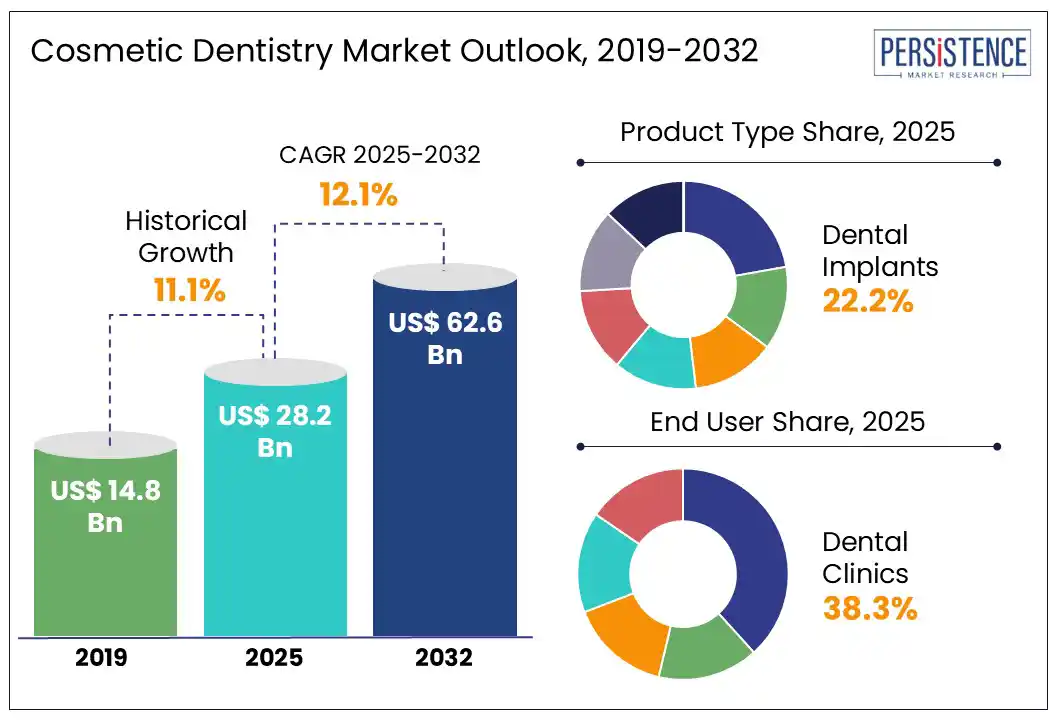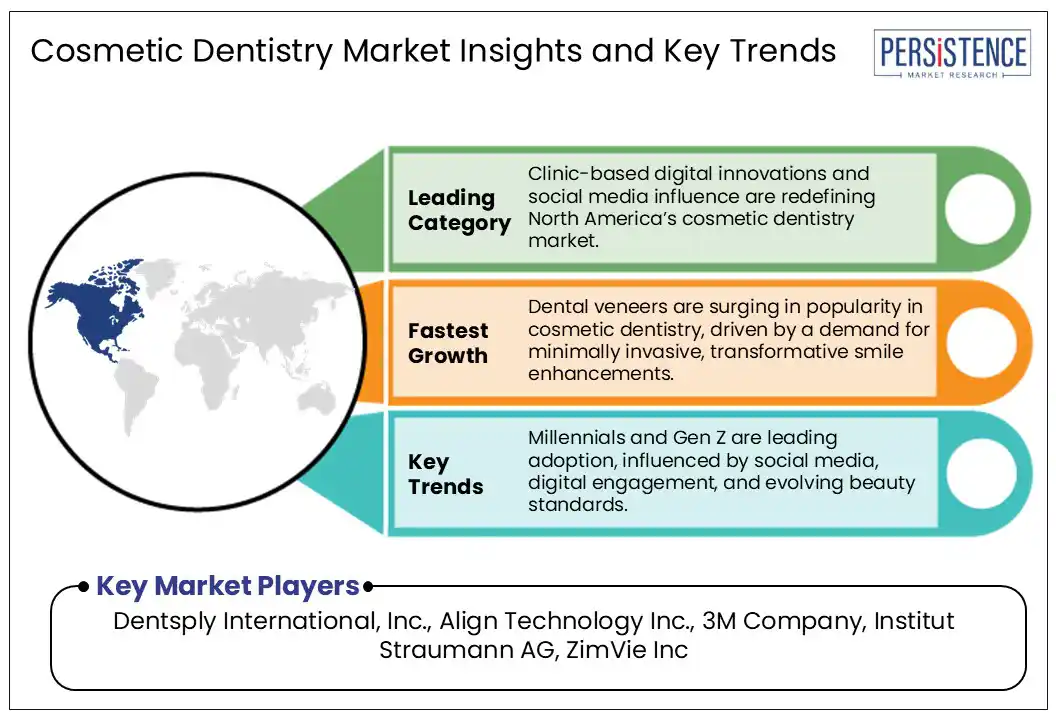ID: PMRREP33186| 165 Pages | 3 Jul 2025 | Format: PDF, Excel, PPT* | Healthcare

The global cosmetic dentistry market size is likely to be valued at US$ 28.2 Bn in 2025, and is expected to reach US$ 62.6 Bn by 2032, growing at a CAGR of 12.1% from 2025 to 2032.
The cosmetic dentistry market is expanding rapidly, driven by rising aesthetic awareness, social media influence, and advancements in dental technology. Key procedures such as veneers, teeth whitening, and clear aligners dominate demand. Innovations, including AI-powered smile design and minimally invasive techniques, are unlocking growth opportunities, particularly in emerging markets.

Key Industry Highlights:
|
Global Market Attribute |
Key Insights |
|
Cosmetic Dentistry Market Size (2025E) |
US$ 28.2 Bn |
|
Market Value Forecast (2032F) |
US$ 62.6 Bn |
|
Projected Growth (CAGR 2025 to 2032) |
12.1% |
|
Historical Market Growth (CAGR 2019 to 2024) |
11.1% |
The increasing focus on appearance among young adults, particularly driven by the pervasive influence of social media, is a key driver for the growth of the cosmetic dentistry market. The online statistics reveal that 45% respondents reported that social media platforms negatively impact their self-confidence. The psychological impact is notably higher among women (53%) than men (35%). In response, 56% have hidden their smiles in photos, while 15% have used digital editing to enhance their teeth before posting. Moreover, 26% feel pressured to change their dental appearance, with younger generations feeling this burden most intensely. This shift in perception has translated into tangible demand, with individuals now willing to spend to improve their smile. As cosmetic dental treatments become more accessible and non-invasive, procedures such as whitening, veneers, and clear aligners are gaining popularity, making dental aesthetics a mainstream personal investment among the youth.
The high expense of cosmetic dental procedures significantly raises the treatment costs. According to patient-facing resources, a porcelain veneer can range from $925 to $2,500 per tooth, while dental implants cost between $1,000 and $6,000 each, and clear aligners range from $3,000 to $10,000. These treatments often fall outside dental insurance, requiring full out-of-pocket payment. Costs vary widely based on procedure type, provider expertise, geographic location, and materials used; for example, porcelain is notably more expensive than composite resin. The combination of high upfront investment, lack of insurance coverage, and specialist fees continues to deter many potential patients, especially younger demographics and those in emerging markets, from pursuing cosmetic dental enhancements.
The adoption of AI and DSD is emerging as a transformative opportunity in the cosmetic dentistry market, enabling a new level of personalization, accuracy, and patient engagement. Advanced tools like SmileFy can generate highly customized smile mock-ups in under five minutes, allowing patients to visualize outcomes before committing to treatment. According to a 2024 study published in the Journal of Esthetic Dentistry, 85% of patients reported increased confidence after viewing AI-generated smile previews.
AI-powered 3D workflows are likely to reduce treatment planning time by up to 60%, enhancing efficiency and precision. These technologies not only improve clinical accuracy but also boost communication between dentists and patients, leading to higher case acceptance rates. With digital dentistry projected to grow at 13.1% annual rate through 2031, the integration of AI and DSD is becoming a strategic differentiator for dental clinics and cosmetic specialists.
Rising demand for minimally invasive and customized aesthetic solutions are expected to increase the demand across practices. These solutions are anticipated to deliver superior outcomes, enhance patient satisfaction, and remain competitive in a rapidly evolving global market.
Dental implants represent a leading product category in the cosmetic dentistry market, accounting for about 22.2% of the segmental share in 2025. Their dominance is driven by rise in global tooth loss. According to the epidemiological studies, over 353 million people were edentulous in 2021, and in the U.S., 178 million adults are missing at least one tooth. Among seniors, 26% have fewer than eight teeth, reinforcing long-term demand.
Implants offer high clinical success rates, making them a preferred choice for permanent tooth restoration. Technological advances such as 3D-guided surgery, same-day implants, and use of zirconia or titanium materials have improved outcomes, reduced chair time, and enhanced patient confidence. With growing cosmetic expectations and aging populations, dental implants continue to anchor the growth of aesthetic dental care.
Dental clinics lead the global cosmetic dentistry market, accounting for approximately 38.3% of the end-user segment share. These outpatient settings are the usual first touchpoint for aesthetic procedures, fuelled by consumer demand for accessible, technology-driven treatments. Clinics increasingly invest in digital tools, such as CAD/CAM and smile design systems to enhance efficiency and patient experience.
With nearly 37 million teeth whitening treatments performed annually across the U.S. in clinics and private practices (Teeth Whitening Statistics 2025) spearheading service delivery, dental clinics are the engine driving cosmetic dentistry adoption. Their outpatient model, flexible pricing, and early technology uptake ensure they remain at the forefront.

North America market is redefined by clinic-based digital innovation and social media influence. In the U.S., approximately 19% of adults have undergone teeth whitening, and nearly 90% of orthodontic patients request whitening services according to the studies conducted, evidence of strong consumer interest in aesthetics.
As aesthetic procedures are performed in dental clinic settings, providers are increasingly investing in technologies such as CAD/CAM systems, intraoral scanners, and AI-powered smile design. According to a survey of U.S. social media users, 53% of people and 72% of Gen Z, compare their teeth on social media, driving heightened demand for visually appealing treatments. These trends highlight how accessibility, affordability, and tech-enabled clinics are shaping cosmetic dentistry's future in North America.
Europe’s cosmetic dentistry landscape balances high-quality aesthetic care with medical tourism. As per a recent survey in the UK, 43% of adults show interest in cosmetic dental enhancements like veneers and whitening. Meanwhile, Eastern European clinics, notably in Hungary, serve 60,000–70,000 dental tourists annually, generating around $325–350 million in revenue.
The EU regulates products such as whitening gels above 0.1% peroxide, reinforcing preference for clinic-based, professionally monitored treatments. With dental implants identified as the largest revenue-generating tourism service in 2023, and orthodontic care following closely, Europe offers a cost-effective yet high-standard model that attracts global patients seeking cosmetic dental work.
Asia Pacific is rapidly emerging as a global hub for cosmetic dentistry, driven by rising disposable incomes, aesthetic consciousness, and a strong medical tourism industry. In 2024, Thailand attracted 6.7 million tourists, with dental services, especially implants and veneers, among the most sought-after treatments. India, a major destination, hosted 2 million medical tourists in 2022, reflecting robust regional and global demand.
Countries such as South Korea, Japan, and Thailand are leading in the adoption of AI-powered smile design and 3D-guided dental workflows, offering personalized and technology-enhanced procedures. These advancements, along with competitive pricing and globally accredited clinics, are making Asia Pacific a key player in the cosmetic dentistry space. The region’s blend of innovation, affordability, and growing self-awareness is reshaping the landscape of regional aesthetic dental care.
The cosmetic dentistry market is characterized by intense competition, driven by rapid technological advancements and evolving patient expectations. Key players compete through innovation in digital workflows, AI-powered smile design, and aesthetic restorative solutions. Companies are investing heavily in research and development to enhance product efficiency, treatment precision, and patient comfort. The rise of dental tourism, particularly in Asia Pacific and Eastern Europe, has intensified global competition with cost-effective, high-quality offerings. Strategic partnerships with DSOs, growing focus on personalized care, and increased adoption of minimally invasive techniques are shaping the competitive dynamics across regional and global markets.
The global market is projected to reach US$ 28.2 bn in 2025.
Rising self-awareness and demand for dental aesthetics among young adults drives the global market.
The global market is poised to witness a CAGR of 12.1% between 2025 and 2032
Adoption of AI and DSD, enabling a new level of personalization, accuracy, and patient engagement, is an opportunity for dental product manufacturers.
Major players include Dentsply International, Inc., Align Technology Inc., 3M Company, Institut Straumann AG, ZimVie Inc., and others.
|
Report Attribute |
Details |
|
Historical Data/Actuals |
2019 - 2024 |
|
Forecast Period |
2025 - 2032 |
|
Market Analysis Units |
Value: US$ Bn/Mn, Volume: As applicable |
|
Geographical Coverage |
|
|
Segmental Coverage |
|
|
Competitive Analysis |
|
|
Report Highlights |
|
|
Customization and Pricing |
Available upon request |
By Product
By End-user
By Region
Delivery Timelines
For more information on this report and its delivery timelines please get in touch with our sales team.
About Author